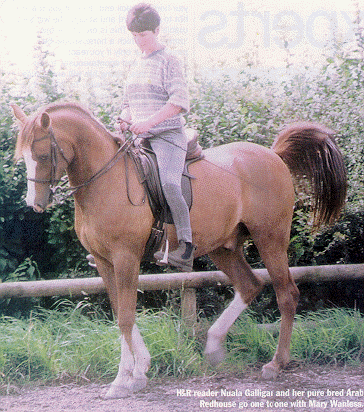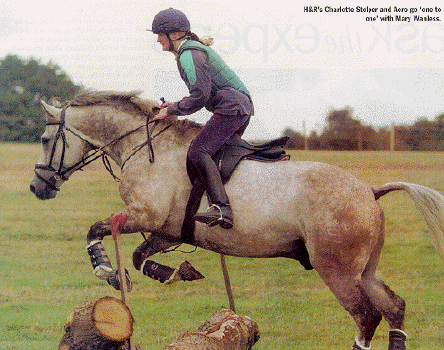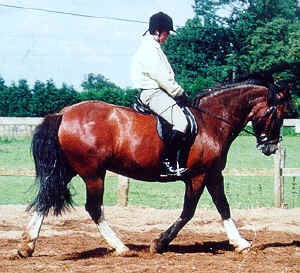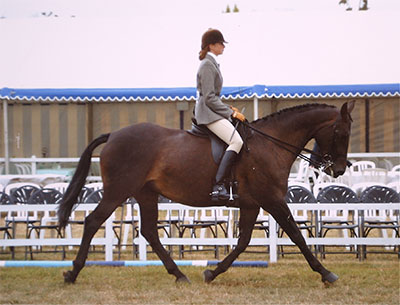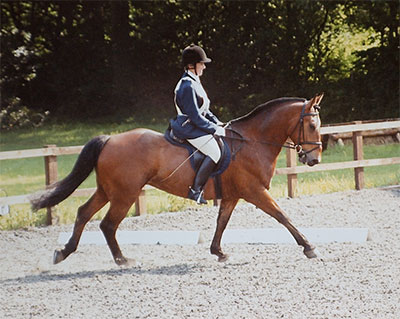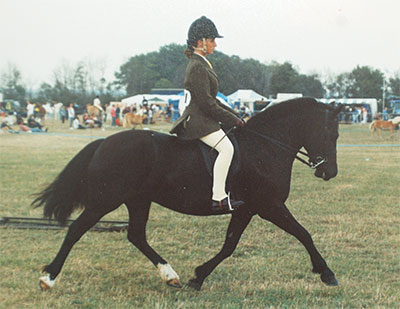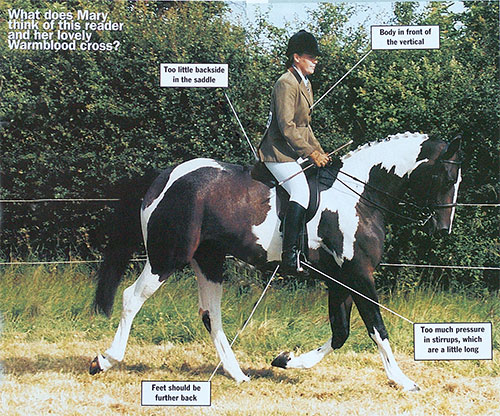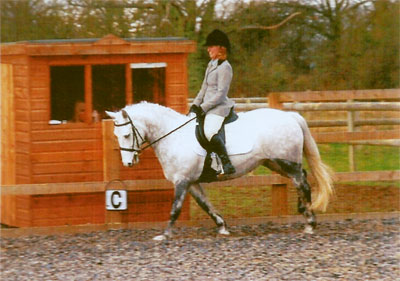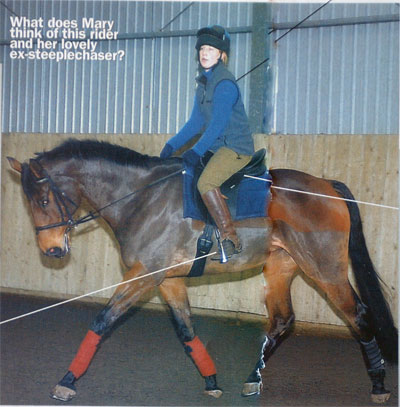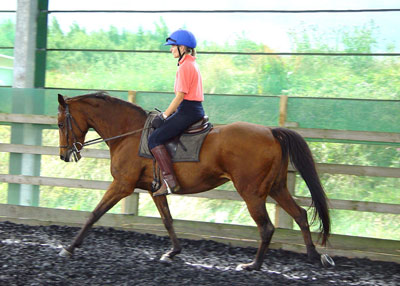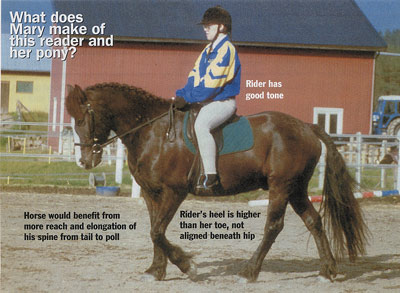RWYM
ARTICLE 17
 The photograph shows a ten year old Cleveland Bay cross Welsh Section D mare. Her rider has owned her for four years, and loves her dearly, even though she describes her horse as a ‘17h hunter on pony legs’!. She describes herself as a ‘happy hacker’ who would like to do some novice dressage, and says ‘I feel that I have no problems encouraging her to accept the contact and she doesn’t lean, but I feel that her lack of impulsion means that she is not coming through from behind enough. How could I improve my position in order to make my seat and legs more effective in generating impulsion and sending her forward?’ At least our rider is realising the importance of good rider biomechanics. In the past she has tried using spurs, but she feels that this created more bucks than forward movement.
The photograph shows a ten year old Cleveland Bay cross Welsh Section D mare. Her rider has owned her for four years, and loves her dearly, even though she describes her horse as a ‘17h hunter on pony legs’!. She describes herself as a ‘happy hacker’ who would like to do some novice dressage, and says ‘I feel that I have no problems encouraging her to accept the contact and she doesn’t lean, but I feel that her lack of impulsion means that she is not coming through from behind enough. How could I improve my position in order to make my seat and legs more effective in generating impulsion and sending her forward?’ At least our rider is realising the importance of good rider biomechanics. In the past she has tried using spurs, but she feels that this created more bucks than forward movement.
Let’s begin by looking at the photograph. Our rider is shown at the top of the rise, and she is just a fraction behind the correct balance point. If we took her horse out from under her by magic, she would topple slightly backwards instead of remaining on her feet. But she is very close to the ideal, and she has a nice line from her elbow through to the horse’s mouth. She is doing far more right than wrong, and I congratulate her on having a rising trot mechanism which works this well. I also congratulate her on realising that change will not come through doing more of the same, or through her horse suddenly deciding not to be lazy. Riding certain exercises is unlikely to produce the key; instead, it will come from changing the way that she sits and rides, thus improving her rider biomechanics..
Looking at the horse, there appears to be much more horse out behind the rider than there is in front of the rider. The mare almost certainly has a long back, but I know from years of experience that when a horse is truly ‘through’, its body looks to be in proportion, with as much horse in front of the rider as there is behind her. (This is even true of the horses who look like pantomime horses when they are not working well!) Remember that this horse can reach to the ground and eat grass, which means that her neck can reach far more out of her wither than it does here. So whilst our rider must be congratulated for riding well enough to have created a rounded topline with her horse staying light in the hand, her next step is to learn how to have more of the horse ‘in front of her’.
At this moment in the stride, we cannot tell how close the horse will come to tracking up i.e. whether the hind hoof will step in or behind the hoof print of the forehoof. This is a measure of the activity of the hind legs. Since our rider regards lack of impulsion as her primary problem, the horse probably won’t track up. But the question is, is the mare simply lazy, with an engine (i.e. hind legs) that does not work hard enough? Or does the rider have the ‘hand brake’ on? Or are there brakes in the horse’s body? This would imply that the power generated by the engine is blocked on its way ‘through’ to the horse’s forehand and neck. The horse with such a blockage ‘thinks backwards’, and can be very difficult to ride. He presents the rider with a problem equivalent to trying to drive your car when the hand brake is still engaged – and the fact that the mare bucks when under pressure suggests to me that she might have such a blockage, probably in her forehand.
I do not think that our rider has herself engaged the hand brake, as her contact appears so light. But she seems, like most riders, to imagine that the problem when the horse does not ‘come through from behind’, lies in the hind legs. But it is not always the engine that is faulty. When it is, the horse has a lazy ‘ho-hum’ attitude to work. When there is a blockage in the system, he tends to have a ‘stuff you!’ attitude. Since the various possibilities are different problems with different solutions, the suggestions that follow are my most inspired guesses.
Once you are ‘in front of the horse’ i.e. your centre of gravity is in front of the horse’s, you can kick and shove for all you are worth, but you will have little effect, for the horse has put you into a powerless position. The secret is to keep your centre of gravity back over his. This idea is a cornerstone of the good rider biomechanics that make the rider effective. Whilst the bomby horse tends to accelerate and pull the rug out forwards from under your feet (which puts your centre of gravity behind his), the lazy horse tends to decelerate and pull the rug out backwards from under your feet (putting your centre of gravity in front of his). This will happen particularly on the corners, where he is unlikely to put in the extra effort that would be needed to maintain the same trot.
When the horse decelerates and/or contracts his body backwards, you must not end up toppling forward or sitting too far forward. Think of the horse like a stuffed toy horse: in the picture, too much of the stuffing has been pushed back behind the rider. Her aim must be to ride her horse so that more of the ‘stuffing’ passes forward under her backside into the horse’s neck. She then needs to hold herself back behind that stuffing. Think of a napkin ring around a napkin: if the rider were the ring and the horse were the napkin, the rider must bring herself further back around the napkin, and must hold herself back there. Then, more of the napkin would be in front of her.
When teaching this idea, I usually suggest that the rider makes her thighs act like buffers. Skilled jumping riders, especially those who ride well across country, offer the best examples of this aspect of rider biomechanics. If the horse attempts to stop, they brace into their thigh (although they would probably tell you that they brace into their feet). Their thigh then remains out in front of them, and their upper body stays upright whilst they kick and use their stick. As less skilled rider topples forward or falls off, and in the process her thighs become more vertical. Bracing into the thigh, and keeping it out in front of you is equally important on the lazy or the ‘backwards’ horse. If your thighs are soggy, too vertical, or off the saddle, you cannot make this work. Your thigh bones must have the quality of iron bars, creating an incompressible boney framework around the horse.
Many riders who have learnt to stay ‘behind their horses’ have been shocked at how far back they had to sit. But the idea soon sells itself to them, because once they get their centre of gravity back over the horse’s, their leg aids begin to work. All of a sudden, the horse takes them far more seriously – their good rider biomechanics are having their magical effect. But they still have to be careful not to over-use the leg, for whenever you kick at every stride (on any horse) your leg soon becomes like background music which he ceases to notice. Our rider should check herself out on this, for it is all too easy to kick every stride on auto-pilot, without even realising that you are doing so! Only an observer can give her a guarantee that this is not happening.
The trick is to keep the meaning in your leg aid, so that if you don’t mean it, you don’t use it, and if you use it, you have to mean it. Meaning it implies that you would back up your leg aid with your stick if necessary. This is an issue for many riders, and often it is fear which keeps riders from awakening their horse from his slumbers. Ask yourself, ‘If you finally galvanised your horse’s energy, how would you cope? Would you be excited and satisfied, or would you be left wishing for the old (safe) status quo?’
Also, for the leg aid to be effective, when you use the leg from the knee down, nothing must change from the knee up. You must not take your thighs and knees off the saddle, allow them to go soggy, or shove with your backside. Your aid must be a slap, which touches the horse and then releases, leaving your leg hanging close to his side but not against it. Do not make the mistake of attempting to produce a stronger aid by making a more prolonged squeeze. It is far less effective than a hearty slap, and the repercussions of squeezing inevitably travel up through your leg.
In short, our rider has to get ‘behind’ her horse, and once the horse is ‘in front of her’, her leg aids will work much better. I think she will need skilled help to achieve this, however, since it requires a new set of skills, invoking an aspect of rider biomechanics which will feel very strane to her.


